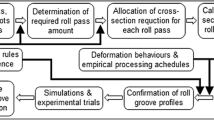Abstract
To maximize the throughput of a hot rolling mill, the number of passes has to be reduced. This can be achieved by maximizing the thickness reduction in each pass. For this purpose, exact predictions of roll force and torque are required. Hence, the predictive models that describe the physical behavior of the product have to be accurate and cover a wide range of different materials. Due to market requirements, a lot of new materials are tested and rolled. If these materials are chosen to be rolled more often, a suitable flow curve has to be established. It is not reasonable to determine those flow curves in laboratory, because of costs and time. A strong demand for quick parameter determination and the optimization of flow curve parameter with minimum costs is the logical consequence. Therefore, parameter estimation and the optimization with real data, which were collected during previous runs, is a promising idea. Producers benefit from this data-driven approach and receive a huge gain in flexibility when rolling new materials, optimizing current production, and increasing quality. This concept would also allow to optimize flow curve parameters, which have already been treated by standard methods. In this article, a new data-driven approach for predicting the physical behavior of the product and setting important parameters is presented. We demonstrate how the prediction quality of the roll force and roll torque can be optimized sustainably. This offers the opportunity to continuously increase the workload in each pass to the theoretical maximum while product quality and process stability can also be improved.
Similar content being viewed by others
References
Barton RR, Meckesheimer M (2006) Metamodel-based simulation optimization. In: Henderson SG, Nelson BL (eds) Simulation, handbooks in operations research and management science, vol 13. Elsevier, pp 535–574. doi:10.1016/S0927-0507(06)13018-2, http://www.sciencedirect.com/science/article/pii/S0927050706130182
Bartz-Beielstein T (2003) Experimental analysis of evolution strategies—overview and comprehensive introduction. Interner Bericht des Sonderforschungsbereichs 531 Computational Intelligence CI–157/03. Universität Dortmund, Germany
Bartz-Beielstein T, Lasarczyk C, Preuß M. (2005) Sequential parameter optimization. In: McKay B. et al (eds) Proceedings 2005 congress on evolutionary computation (CEC’05), Edinburgh, Scotland, vol 1. IEEE Press, Piscataway, pp 773–780
Bartz-Beielstein T, Parsopoulos KE, Vrahatis MN (2004) Design and analysis of optimization algorithms using computational statistics. Appl Numer Anal Comput Math (ANACM) 1(2):413–433
Bartz-Beielstein T, Zaefferer M (2012) A gentle introduction to sequential parameter optimization. Tech. Rep. TR 01/2012. CIplus
Forrester A, Sóbester A., Keane A (2007) Multi-fidelity optimization via surrogate modelling. Proc R Soc A: Math Phys Eng Sci 463(2088):3251–3269. doi:10.1098/rspa.2007.1900
Forrester A, Sobester A, Keane A (2008) Engineering design via surrogate modelling. Wiley
Hajduk M, Zidek M, Elfmark J, Kopec S (1972) Derivation of mean values of inherent deformation resistance in hot rolling of tonnage steel. Hutn Listy 27(8):567
Hajduk M et al (1972) Effect of improper selection of the rpm of vertical and horizontal drives on balanced rolling force distribution in a universal rolling mill. Hutn Listy 27(8):259
Hensel A, Spittel T (1978) Kraft- und Arbeitsbedarf bildsamer Formgebungsverfahren. Verlag Grundstoffindustrie
Hernandez C, Medina S, Ruiz J (1996) Modelling austenite flow curves in low alloy and microalloyed steels. Acta Mater 44(1):155–163. doi:10.1016/1359-6454(95)00153-4. http://www.sciencedirect.com/science/article/pii/1359645495001534
Hinkfoth R (2003) Massivumformung. Wissenschaftsverlag, Aachen
Jin Y (2005) A comprehensive survey of fitness approximation in evolutionary computation. Soft Comput 9(1):3–12
Jones D, Schonlau M, Welch W (1998) Efficient global optimization of expensive black-box functions. J Glob Optim 13:455–492
Jones DR (2001) A taxonomy of global optimization methods based on response surfaces. J Glob Optim 21:345–383. doi:10.1023/A:1012771025575
Kleijnen JPC (2008) Design and analysis of simulation experiments. Springer, New York
Lambiase F (2013) Optimization of shape rolling sequences by integrated artificial intelligent techniques. Int J Adv Manuf 68(1–4):443–452
Mancini E, Campana F, Sasso M (2012) Newaz, G.: Effects of cold rolling process variables on final surface quality of stainless steel thin strip. Int J Adv Manuf 61(1–4):63–72
Mandal S, Rakesh V, Sivaprasad S, Venugopal S, Kasiviswanathan KV (2009) Constitutive equations to predict high temperature flow stress in a Ti-modified austenitic stainless steel. Mater Sci Eng
Nelder J, Mead R (1965) A simplex method for function minimization. Comput J 7:308–313
Powell M (1988) A review of algorithms for nonlinear equations and unconstrained optimization. In: Proceedings ICIAM, pp 220–232
Powell M (1992) A direct search optimization method that models the objective and constraint functions by linear interpolation. Tech. Rep. DAMTP 1992/NA5, Department of Applied Mathematics and Theoretical Physics, University of Cambridge, England
Sacks J, Welch WJ, Mitchell TJ, Wynn HP (1989) Design and analysis of computer experiments. Stat Sci 4(4):409–435
Sheu JJ (2004) Simulation and optimization of the cold roll-forming process. In: AIP. AIP, Melville, pp 452–457
Sun J, Du F, Li X (2008) FEM Simulation of the roll deformation of six-high CVC mill in cold strip rolling. In: 2008 international workshop on modelling, simulation and optimization (WMSO). IEEE, pp 412–415
Tselikov A, Nikitin G, Rokotyan S (1981) The theory of lengthwise rolling. Mir Publishers
Weber K (1973) Grundlagen des Bandwalzens. Leipzig, VEB Deutscher Verlag fuer Grundstoffindustrie
Lin Ming-Song YC, Chen JZ (2008) Prediction of 42crmo steel flow stress at high temperature and strain rate. Mech Res Commun
Author information
Authors and Affiliations
Corresponding author
Rights and permissions
About this article
Cite this article
Jung, C., Zaefferer, M., Bartz-Beielstein, T. et al. Metamodel-based optimization of hot rolling processes in the metal industry. Int J Adv Manuf Technol 90, 421–435 (2017). https://doi.org/10.1007/s00170-016-9386-6
Received:
Accepted:
Published:
Issue Date:
DOI: https://doi.org/10.1007/s00170-016-9386-6




